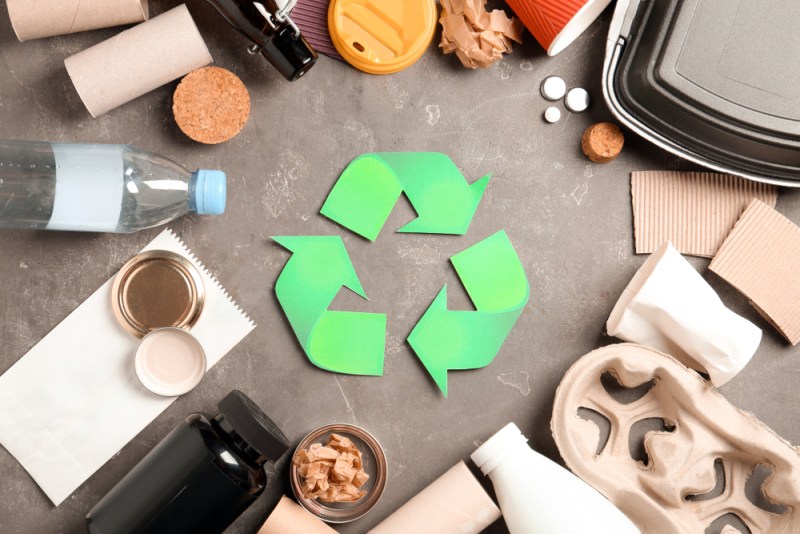Brita
Sponsored Content
Remember life before we recycled? Neither do we. For most of us, saving our takeout containers and flattening our cereal boxes for our recycling bins, and then hauling the whole heap out to the curb, has become second nature. In fact, you’ve probably been recycling for so long that you may be following some outdated rules about what belongs (and doesn’t belong) in those bins. We’ll debunk five of the most common assumptions.
1. MYTH: Most Single-Use Plastic Bottles Are Recycled

Surprisingly, this isn’t the case. While recycling rates are on the rise, and almost all materials recovery facilities (MRF) can process plastic bottles, only 29 percent of plastic bottles made with polyethylene terephthalate (PET) are recycled in the United States. Shocking, right? The benefits of recycling seem obvious: recycling reduces the amount of waste sent to landfills and prevents that waste from leaking into the environment. So, what gives? Research suggests that it largely comes down to convenience and commitment. If recycling requires us to go out of our way — for example, if curbside pickup isn’t available, or if on-the-street recycling bins are few and far between — recyclables are more likely to end up in the garbage. Think about it — how many times have you found yourself with an empty water bottle in hand and no recycling bin in sight? It happens all the time.
Instead of leaving your decision to recycle in the hands of fate (or of a local municipality’s decision to fund only a few corner recycling bins), you can take a stand by simply reducing your consumption of single-use plastic bottles. Use a Brita Monterey pitcher equipped with a Longlast™ filter to eliminate the need for plastic water bottles at home (where 60 percent of bottled water is consumed) and at the office, and keep a filtering water bottle handy when you’re on the go to avoid being faced with recycling dilemmas.
2. MYTH: It’s No Big Deal If You Put The Wrong Things In The Bin

Not true. But this belief is pervasive. In fact, about 25 percent of detritus that’s thrown into recycling bins actually isn’t recyclable through curbside programs. If you toss in castoffs that can’t be processed (like wires, hoses, and low-grade plastics), you risk contaminating the whole load. This means that your perfectly fine recyclables might not end up being recycled or that the quality of the recyclable materials will be lower. Aside from contaminating the containers that actually can be processed, these items can create problems for processing machinery and even pose hazards to workers. While recycling programs are accepting a wider range of materials than they used to, it’s still important to follow local recycling rules.
3. MYTH: If Something Has The Recycling Arrows On It, It’s Recyclable

Yes and no. As a responsible citizen, you probably do a quick scan for the recycling symbol before tossing a plastic item into the garbage or the recycling bin. But the iconic arrows don’t necessarily mean that the container or bottle will be accepted by your local recycling program. It all comes down to what technologies and infrastructure are available in your community. It’s also important to note that the resin identification code (the triangular symbol with a number in the middle typically found on plastic products) is also not an indicator of an item’s recyclability. It is only intended to differentiate between types of plastics. Every city is different. Before you throw something away, check what yours actually recycles to avoid accidentally contaminating the recycling stream.
4. MYTH: You Don’t Need To Rinse Containers Before Putting Them In The Recycling Bin

Though the recycling process involves washing, many recycling programs will not accept materials that have food residue on them. Unfortunately, materials that are deemed too dirty get a one-way ticket to the landfill or incinerator. Giving packaging and containers a quick rinse can help optimize the recycling process and the quality of the recycled materials. Packaging doesn’t have to be spotless, but containers should be empty and with little residue. Containers that held soap, such as bottles of dishwashing liquid or laundry detergent, don’t need to be rinsed out (they actually help facilitate the washing process!). Oh — and those greasy pizza boxes? They’re better off in the compost pile than the recycling bin.
5. MYTH: Recycling Alone Can Solve Our Planet’s Growing Waste Problem

Recycling has a lot of great benefits, from drastically reducing the amount of virgin materials (as well as the water and energy) needed to produce new products to preventing waste from entering our oceans and beyond. But simply making products recyclable — and ensuring they land in the right receptacles — won’t solve our planet’s mounting waste problem. There’s a reason reduce and reuse come before recycle. Reducing our overall consumption of single-use disposables and opting for durable, reusable items will produce significantly better environmental outcomes than recycling on its own. For example, switching from bottled water to a Brita pitcher and Longlast™ filter can save up to 1,800 plastic bottles in just one year. Buying food in bulk or freezing leftovers instead of purchasing ready-made frozen meals is another easy way to reduce your plastic footprint.
Recycling is an important strategy for reducing waste, curbing pollution, and promoting resource efficiency, but its benefits can’t be realized if it isn’t done right. So be sure to familiarize yourself with the dos and don’ts of your local recycling program.

